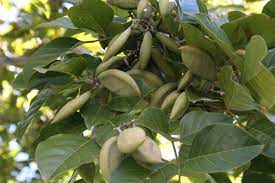
Culture
Start-up Plans to Use Miracle Tree to Address Climate and Hunger Issues
“Miracle trees” known as Pongamia, which can thrive in parched deserts and produce goods akin to olive and soybean oil, are the goal of startup Terviva.
Canary Media’s Eating the Earth blog examines the link between our dietary choices and the climate in which we live.
It would be a miracle if the world could be fed without frying the world. We’d have to find a way to produce far more food while consuming far less land. We’d also have to plant a lot more trees if we wanted to lessen the quantity of atmospheric carbon while also increasing the level of carbon stored on Earth.
It appears that a miracle has occurred.
This tropical tree, known as Pongamia, has agricultural superpowers that make it look like a regular tropical tree. However, unlike soybeans, it can generate far greater nutrition for every acre than soybeans, making it a viable alternative to soybeans.
Even on the most deteriorated terrain, it may thrive without the use of herbicides or irrigation. Due to its ability to remove both carbon and nitrogen from the atmosphere, it rarely necessitates the use of fertilizer, which has the additional effect of speeding up climate change.
With this in mind, it can be said that it is the ideal crop for a planet that is becoming increasingly hot and hungry while also experiencing a severe pollution problem from agricultural pesticides. Modern farming is under fire for contaminating and depleting soils, but Pongamia can help stabilize and regenerate the soil.
While agriculture is responsible for one-third of global emissions, Pongamia farming reduces emissions by sequestering roughly five tons of carbon annually per acre.
Pongamia is a reforestation crop that can rebuild deforestation products like palm and soy oil with no need for the use of chemicals, diesel tractors, or even add water. Pongamia is virtually a response to prayer for the earth. In a warming world, it’s an incredibly hardy, self-sufficient tree that can thrive in the harshest conditions, even amid a jungle.
Pongamia, which has been growing wild in Australia and South Asia for many thousand years, has just recently been domesticated and reimagined as a power crop in the US. Even so, if we’re going to reach the objectives of the Paris treaty while expanding agricultural output by 50 percent for feeding 10 billion individuals, we’ll need some revelations.
A lack of familiarity with Pongamia suggests that this column won’t be a continuous stream of positive news about the world’s agriculture sector. As a result of devastating depletion in Africa and other countries and the ongoing conflict in Ukraine, the global food supply is in jeopardy.
However, the harvest is truly awe-inspiring and extraordinary. For the sake of humanity, it may be a boon to the globe. Tervita, the Oakland-based business attempting to make Pongamia accessible to the general public, also has a fascinating and amazing narrative to tell.
Culture
India Reigns Supreme in Big Cat Conservation: Celebrating Success and Setting New Goals
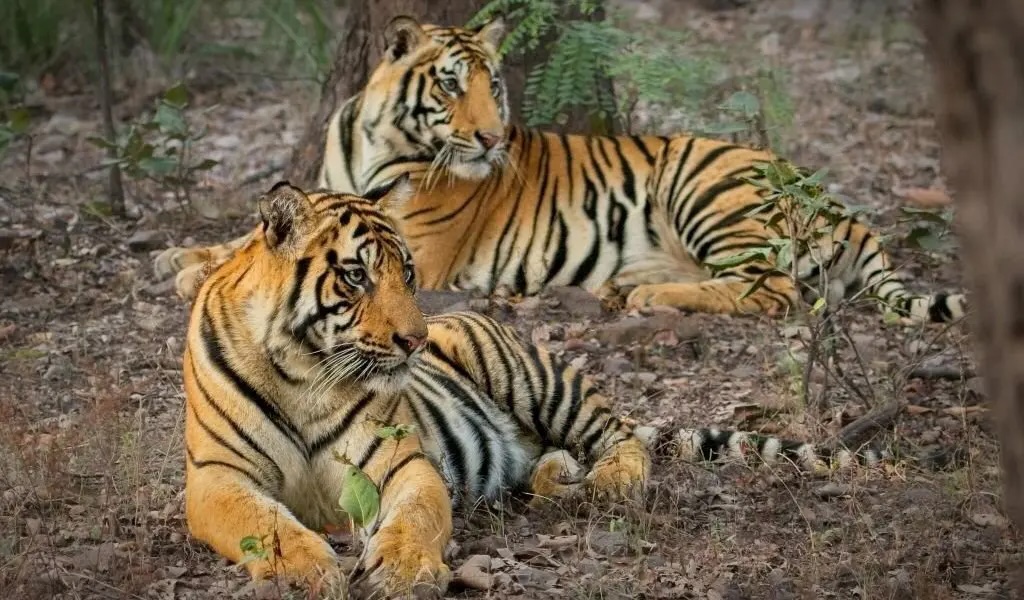
India is now recognized as a global leader in the conservation of big cats, boasting control of 75% of the world’s wild tiger population, serving as the sole sanctuary for Asiatic lions, and celebrating the successful reintroduction of cheetahs. Additionally, populations of leopards and snow leopards in the country are witnessing promising growth. This impressive conservation narrative is getting a further boost with the formation of the International Big Cat Alliance (IBCA), which was officially launched by the Union Cabinet with a funding of Rs 150 crore till 2028. The IBCA secretariat will be headquartered in India, underlining the country’s pivotal role in global big cat conservation efforts.
The Genesis and Goals of the International Big Cat Alliance
Prime Minister Narendra Modi unveiled the IBCA in April 2023 in Mysuru, marking the 50th anniversary of Project Tiger. The alliance aims to foster international collaboration for the preservation of seven key big cat species: lions, tigers, leopards, cheetahs, snow leopards, jaguars, and pumas. India houses five of these species, excluding only the jaguar and puma. This alliance encompasses 96 big cat range countries and various conservation and scientific organizations, demonstrating a robust international effort to protect these vulnerable and endangered species.
Asiatic Lion Conservation: A Beacon of Success
The only wild population of Asiatic lions resides in Gujarat’s Gir National Park and its surroundings, with the population reaching 674 in 2020, up from 523, marking an unprecedented growth rate of 28.87%. This species, once on the brink of extinction with numbers as low as 20, has seen remarkable recovery thanks to dedicated conservation efforts beginning well before India’s independence and formally initiated by the Indian Forest Service in 1965. Plans are now underway to relocate some lions to the Badra Wildlife Sanctuary to manage overpopulation risks in Gir.
Project Tiger: A Legacy of Triumph
India celebrates the resounding success of Project Tiger, initiated in 1973 to reverse the dire decline of tigers from around 40,000 at independence to below 2,000 by 1970 due to rampant hunting and poaching. Today, India hosts 3,682 tigers, a nearly 24% increase from 2018, spread across 53 reserves. This success story is a result of stringent anti-poaching laws, habitat conservation, and local community engagement, positioning India as a leader in tiger tourism and conservation compared to other Asian nations.
The Return of the Cheetah
India has reintroduced cheetahs to its fauna, with initial translocations from Namibia and South Africa to Madhya Pradesh’s Kuno National Park. This reintroduction project has faced challenges, but the recent birth of cubs and a survival rate meeting the project’s early goals highlight its potential success. The program aims to not only revive the cheetah population but also to foster ecological tourism and local economic development.
Leopard and Snow Leopard: Thriving Against Odds
Leopards, despite being the smallest of the large cats in India, are flourishing with a population increase from 12,852 in 2018 to 13,874 in 2022. This growth is credited to comprehensive conservation efforts across various states. Similarly, the elusive snow leopard, primarily found in high-altitude regions of the Himalayas, has been systematically surveyed, revealing a stable population that underscores India’s commitment to preserving its natural heritage.
India’s proactive and successful conservation initiatives for big cats not only enhance biodiversity but also bolster local communities and economies, reinforcing the nation’s commitment to maintaining the delicate balance between human progress and environmental stewardship.
Culture
South Africa Plans to Stop Lion Breeding for Hunts
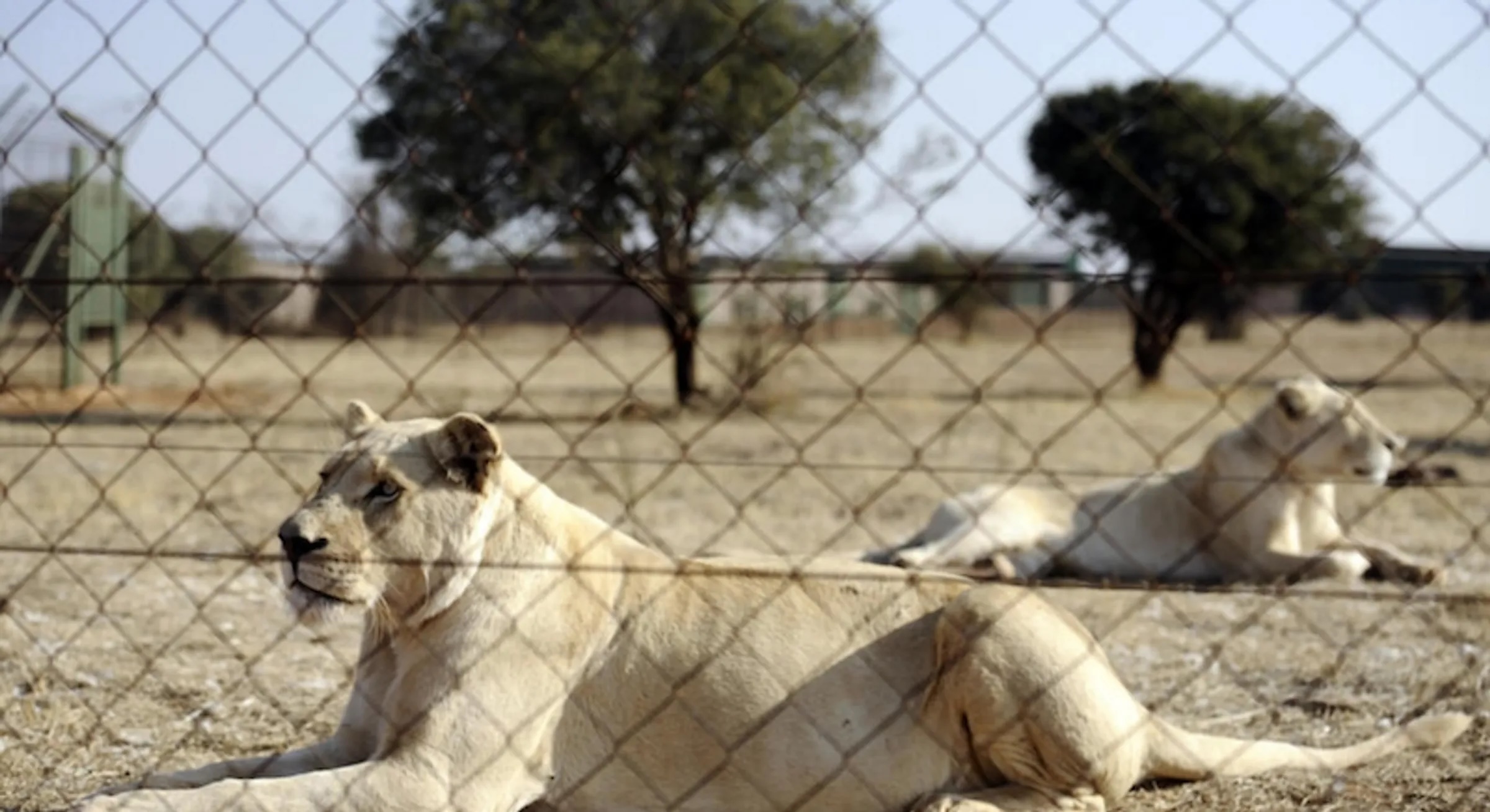
South Africa announced its plan on Wednesday to gradually stop the breeding of lions for hunting. This decision aims to end the business that has been criticized for a long time. This business involves raising big cats so that rich hunters, who pay a lot of money, can hunt them. These hunters often take parts of the lions, like their heads or skins, as trophies to keep.
The South African government had already shown its desire to stop lion breeding for hunts in 2021. A special group has been working on this matter for two years. Environment Minister Barabara Creecy, during a news conference in Cape Town, said that this group suggested shutting down the industry. This includes stopping the breeding of lions, keeping them captive, or selling anything obtained from captive lions.
Lion breeders have two years to stop their activities voluntarily and find a different business to do before this new rule is enforced. Even though this plan has met with resistance from the industry, which makes a lot of money, the government approved it recently. However, it’s not yet an official law.
This step is taken as more people, especially in Western countries, are against trophy hunting. Efforts to stop trophy imports are gaining support in the United States, Australia, and some European countries. Kamalasen Chetty, who leads the special group, mentioned that the lion breeding industry is big and complicated. It has a long history but doesn’t fit with the latest international trends or changes in local conservation policies.
Animal rights organizations estimate that there are between 8,000 and 12,000 lions on around 350 farms in South Africa. These groups often criticize the way these animals are kept. In contrast, there are only about 3,500 wild lions, as reported by the Endangered Wildlife Trust, an organization based in South Africa.
Culture
Research Finds That Birds Can Be Polite
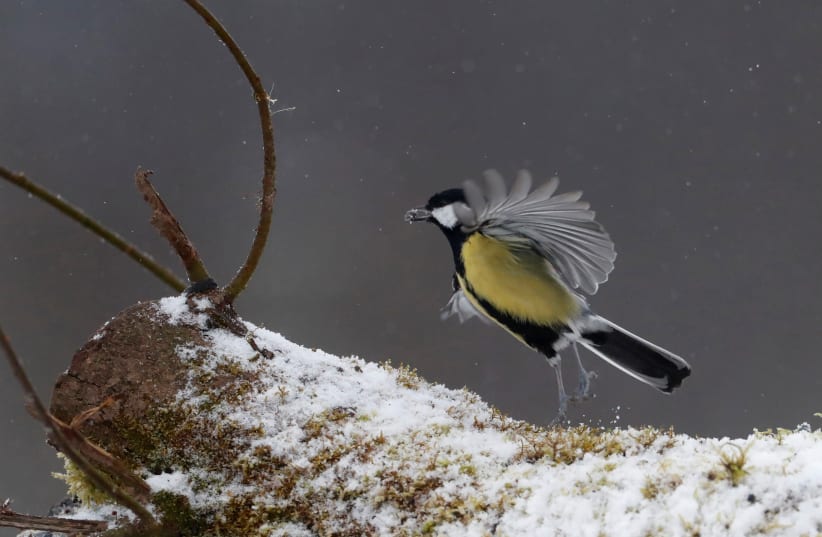
Did you know that birds can be polite, just like humans? Researchers have found that the Japanese tit, a small bird found in Japan, has a unique way of showing politeness through its wing gestures. This fascinating discovery gives us a glimpse into the complex world of bird communication.
At the University of Tokyo, Professor Toshitaka Suzuki and his team studied these birds and made some amazing discoveries. They noticed that when a pair of Japanese tits arrives at their nest box with food, they don’t rush in. Instead, they wait on nearby perches. What happens next is intriguing: one bird flutters its wings toward the other, as if to say, “After you.” This gesture is like holding the door open for someone, showing respect and care.
The Japanese tit, scientifically known as Parus minor, is not just any bird; it’s known for its intelligence and complex behaviors. Professor Suzuki, who has been studying these birds for over 17 years, found that they use specific calls and even combine these calls into phrases, much like how we form sentences. This shows how advanced their communication skills are.
In their study, published in the journal Current Biology, the researchers observed that these wing-fluttering gestures happened mainly between mates and were a clear sign for one to enter the nest before the other. Interestingly, it was usually the female that made the gesture, inviting the male to go first.
This behavior has led scientists to think about how gestures evolved in the animal kingdom. Just like humans developed gestures by using their hands more when they started walking on two legs, birds might have developed gestures by using their wings while perching.
The research on the Japanese tit is part of a larger effort to understand how animals communicate, not just with sounds but also with physical movements. This could help us learn more about how language and communication developed, even in humans.
So, the next time you see birds, think about the complex and polite ways they might be communicating right in front of your eyes!
Culture
Volunteers and Camels Team Up to Restore Mojave Desert’s Joshua Trees
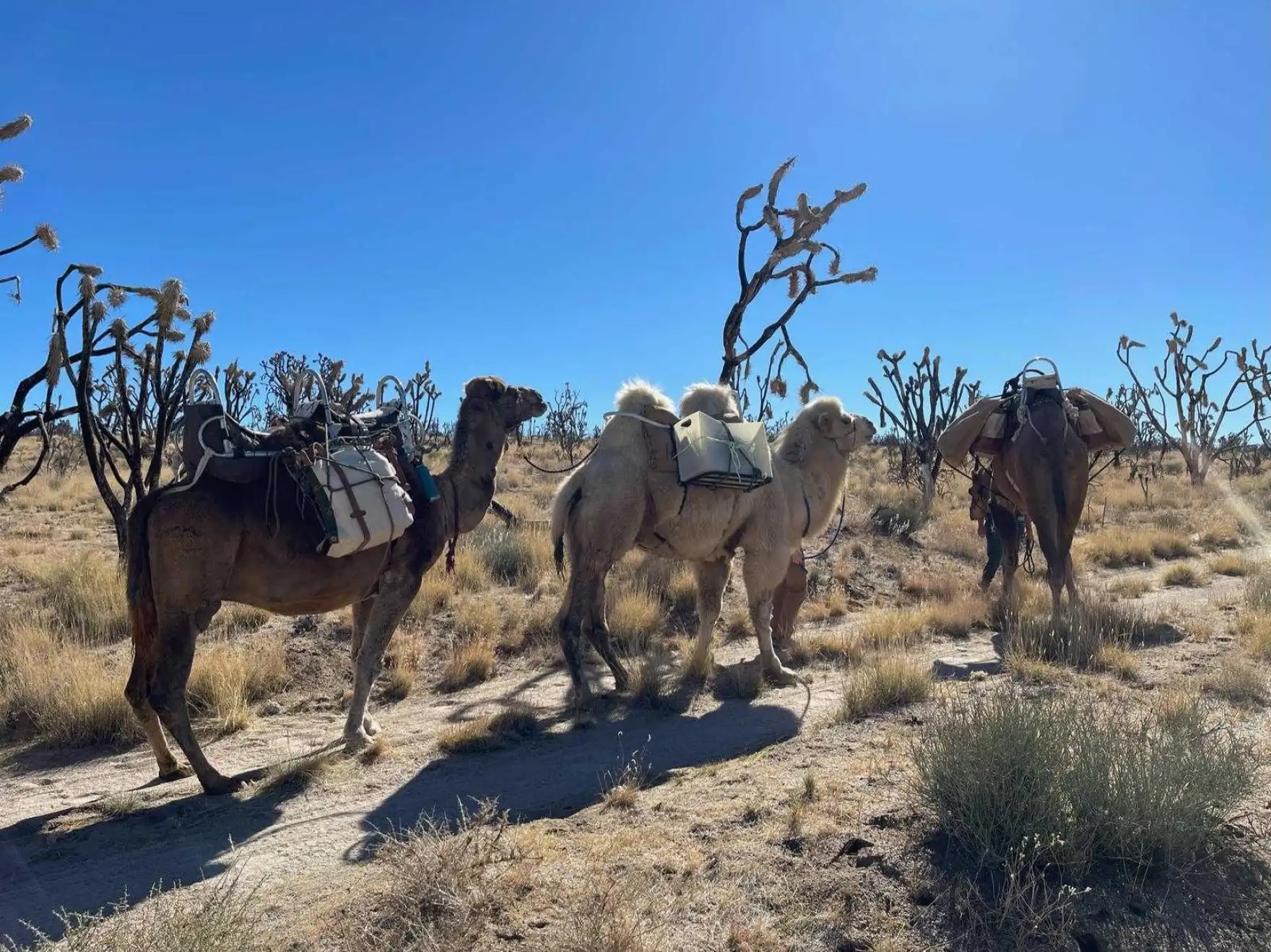
The Mojave Desert, with its vast, arid landscape, is home to the iconic Joshua tree. These unique trees have a fascinating history, once coexisting with Giant Ground Sloths during the ice age and now relying on rodents for their slow dispersal. However, a devastating wildfire in 2020 burned a significant portion of the desert, including many Joshua trees, posing a challenge for their restoration.
“Joshua trees seeds don’t spread very quickly,” explained Debra Hughson, deputy superintendent at the Mojave National Preserve. “They don’t move very fast or they don’t move very far with just small mammals around.” Despite these challenges, scientists were determined to help the Joshua trees recover, especially in areas like Cima Dome, where their survival could be crucial in the face of climate change.
To accelerate the recovery process, Hughson and her colleagues decided to plant Joshua tree seedlings in a more spaced-out pattern in the Dome’s burn scar. This approach aimed to distribute seed sources and promote the recovery of the entire area. However, the rugged terrain made it difficult for volunteers to reach the designated planting spots, requiring hours of hiking.
To address this challenge, the team came up with a unique solution — using camels to transport the seedlings and water into the wilderness. “Prehistoric camels were in the Mojave Desert, and the camels came through in 1857,” explained one of the volunteers, highlighting the historical connection between camels and the region. The camels, led by Herbie, Sully, and Chico, have been instrumental in carrying out these restoration efforts since 2021.
“Our goal is to protect natural systems and natural ecosystems — all the plants, all the animals, but then some animals and some plants wind up being just a little bit more ‘charismatic’ than other ones,” said Hughson, emphasizing the importance of charismatic species like the Joshua tree in garnering support for conservation efforts.
Through the dedication of volunteers and the help of these remarkable camels, the Mojave Desert’s Joshua trees are slowly making a comeback, offering hope for their future in this challenging environment.
Culture
Apes’ Playful Teasing Behavior Mirrors Human Playfulness
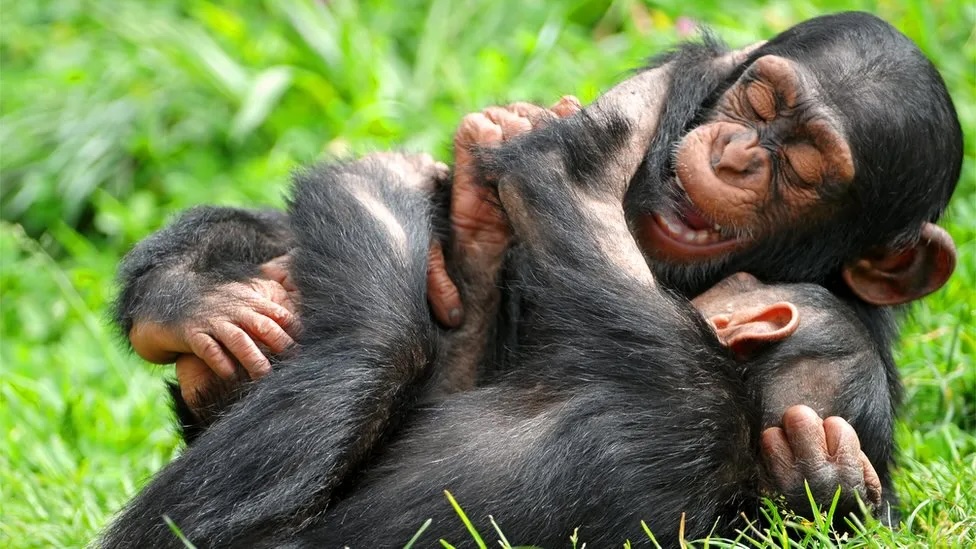
Did you know that apes like to tease and prank each other, just like humans do? Researchers have found that chimpanzees, bonobos, gorillas, and orangutans engage in playful teasing behavior, such as poking, tickling, body slamming, hair pulling, and waving objects in front of faces. This behavior is usually one-sided, with one ape trying to get a reaction from another.
In a study published in the journal Proceedings of the Royal Society B Biological Sciences, researchers analyzed 75 hours of video footage of apes at the San Diego Zoo in California and the Leipzig Zoo in Germany. The apes studied were between the ages of 3 and 5. The researchers observed 284 instances of teasing behavior, with 129 meeting the criteria for playful and provocative behavior. They identified 18 different teasing behaviors.
Professor Erica Cartmill of UCLA, who led the study, said that teasers often waved or swung body parts or objects in front of the other ape, hit or poked them, stared closely at their face, disrupted their movements, pulled their hair, or performed other behaviors that were hard to ignore.
The researchers believe that playful teasing and joking may have evolved in human ancestors around 13 million years ago. This behavior has implications for the study of emotion, humor, and pretense, and the researchers hope that their study will inspire further research into playful teasing in other species to better understand its evolution.
-

 OMG6 years ago
OMG6 years agoA Couple Gave Birth to the Most Beautiful Twins Ever
-

 OMG6 years ago
OMG6 years ago20 Rare Historical Photos
-

 OMG6 years ago
OMG6 years agoHilarious Airport Photos
-

 Cute6 years ago
Cute6 years agoMom Refuses to Let Daughter Eat Sugar and Years Later This is What She Grows Into
-

 OMG5 years ago
OMG5 years agoTop Secret Air Force One Facts That You Never Knew
-
OMG5 years ago
The Funniest Yearbook Photos Of All Time
-

 OMG6 years ago
OMG6 years agoRetired Mathematician Restores Log Cabin
-

 OMG4 years ago
OMG4 years agoWhat Happened When This ‘Duck Dynasty’ Legend Chopped Off His Beard?